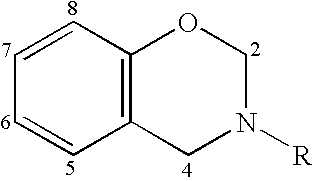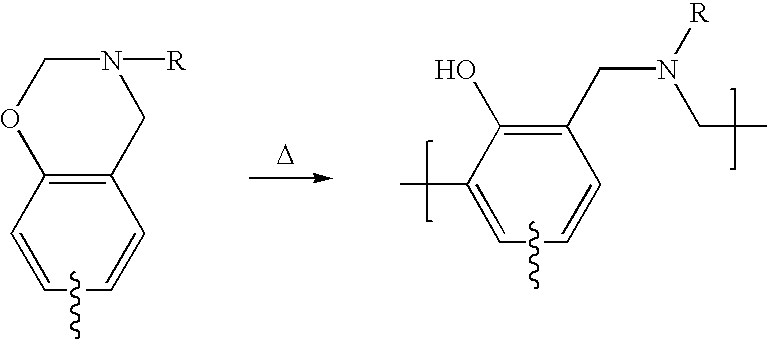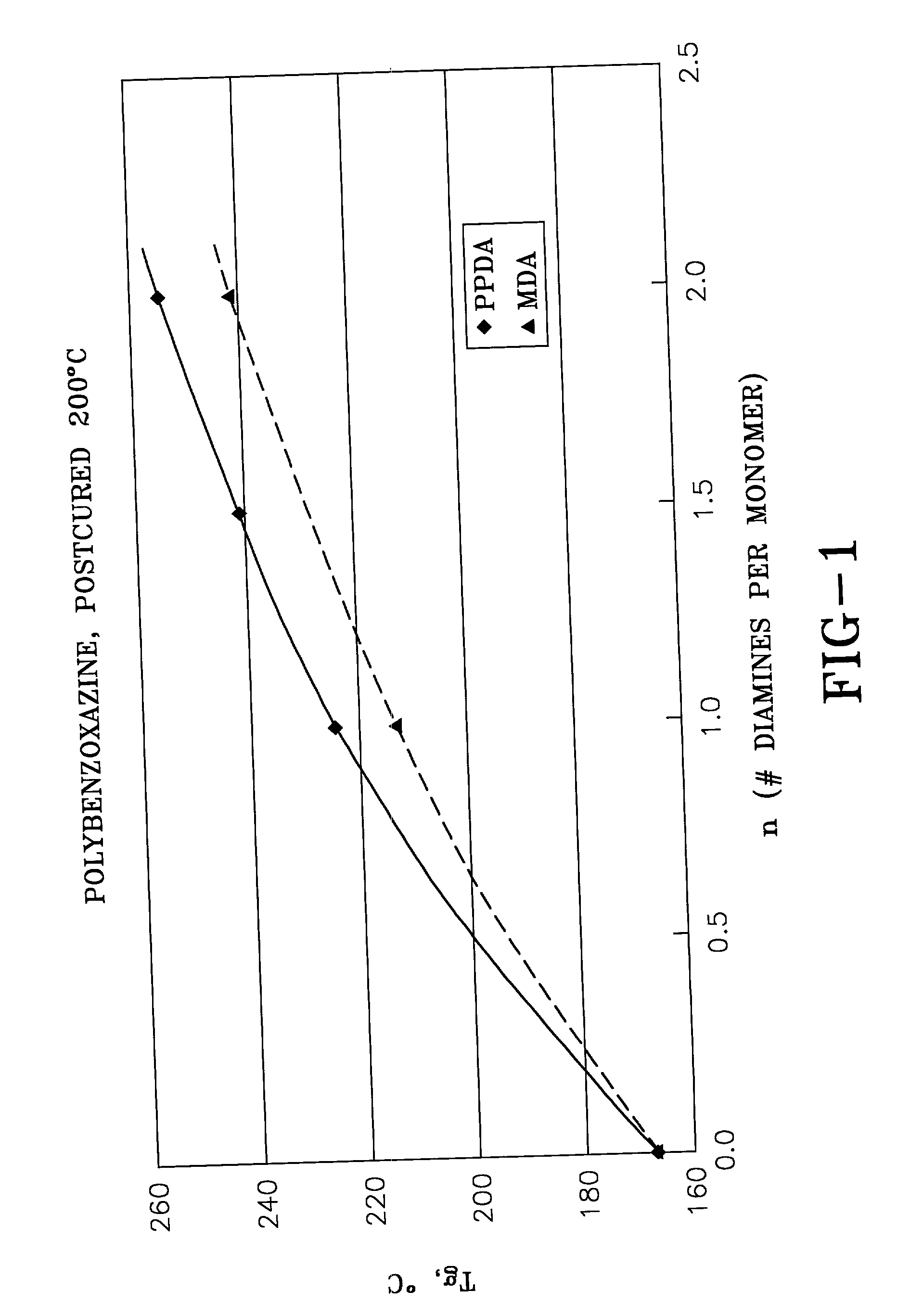Enhancement of thermal properties of benzoxazine polymers by use of aromatic polyamines to incorporate internal benzoxazine groups within the monomer
a technology of benzoxazine and polymer, which is applied in the direction of organic chemistry, etc., can solve the problems of high cost of reactants, unsatisfactory need to achieve, and use of reactants
- Summary
- Abstract
- Description
- Claims
- Application Information
AI Technical Summary
Problems solved by technology
Method used
Image
Examples
example 1
[0057] Benzoxazine Resin Without Polyamine (n=0) Prepared in Solvent; F.M.W.=462 g / mole
[0058] A 3000-mL glass kettle was placed in an ice bath to keep it cool. 600 g of toluene and 100 g of ethyl acetate were added, followed by 168.5 g of formalin (2.08 moles), 483.2 g of aniline (5.19 moles), 262.4 g. of paraformaldehyde (8.30 moles), and 592.3 g of bisphenol A (2.60 moles). The mixture was slowly heated to reflux at 84C. Reflux was maintained for 31 / 2 hr., during which time 184 g of aqueous phase was removed (out of calculated 326 g total). The final resin solution was off-white in color and opaque, with no visible particulates.
[0059] The resin solution was converted into molding compound by mixing 1100 g of it with 471.4 g of milled carbon fiber and 134.6 g of graphite powder. The wet mixture was first dried in a vacuum oven at about 70C for 11 / 2 hr and then in an air-circulating oven at 110C for 3 hr more. The dried molding compound was granulated and then molded into a plaque m...
example 2
[0060] Benzoxazine Resin with PPDA (n=1) Prepared in Solvent; F.M.W.=846 g / mole
[0061] A 3000-mL glass kettle was placed in an ice bath to keep it cool. 700 g of toluene and 100 g of ethyl acetate were added, followed by 230.0 g of formalin (2.84 moles), 264.0 g of aniline (2.84 moles), 268.8 g of paraformaldehyde (8.51 moles), 153.2 g of p-phenylenediamine (1.42 moles), and 646.8 g of bisphenol A (2.84 moles). The mixture was slowly heated to reflux at 83C. Reflux was maintained for about 2 hr, during which time 152 g of aqueous phase was removed (out of calculated 386 g total). The final resin solution was tan, opaque and snotty, but it poured well.
[0062] The resin solution was converted into molding compound by mixing 1220 g of it with 414.6 g of milled carbon fiber and 118.5 g of graphite powder. The wet mixture was first dried in a vacuum oven at about 70C for 3 / 4 hr and then in an air-circulating oven at 113C for 3 hr more. The dried molding compound was granulated and then mol...
example 3
[0063] Benzoxazine Resin with PPDA (n=1.5) Prepared in Solvent; F.M.W.=1039 g / mole
[0064] A 3000-mL glass kettle was placed in an ice bath to keep it cool. 770 g of toluene and 130 g of ethyl acetate were added, followed by 210.8 g of formalin (2.60 moles), 242 g of aniline (2.60 moles), 328.4 g of paraformaldehyde (10.39 moles), 210.7 g of PPDA (1.95 moles), and 741.3 g of bisphenol A (3.25 moles). The mixture was slowly heated to reflux at 83.degree. C. Reflux was maintained for about 2 hr, during which time 145 g of aqueous phase was removed (out of calculated 398 g total). The final resin solution had a uniform tan color and was relatively fluid. The resin solution was converted into molding compound by mixing 1620 g of it with 561.3 g of milled carbon fiber and 160.5 g of graphite powder. The wet mixture was first dried in a vacuum oven at about 70C for 1.5 hr and then in an air-circulating oven at 113.degree. C. for 3 hr more. The dried molding compound was granulated and then ...
PUM
| Property | Measurement | Unit |
|---|---|---|
| Fraction | aaaaa | aaaaa |
| Percent by mass | aaaaa | aaaaa |
| Angle | aaaaa | aaaaa |
Abstract
Description
Claims
Application Information
 Login to View More
Login to View More - R&D
- Intellectual Property
- Life Sciences
- Materials
- Tech Scout
- Unparalleled Data Quality
- Higher Quality Content
- 60% Fewer Hallucinations
Browse by: Latest US Patents, China's latest patents, Technical Efficacy Thesaurus, Application Domain, Technology Topic, Popular Technical Reports.
© 2025 PatSnap. All rights reserved.Legal|Privacy policy|Modern Slavery Act Transparency Statement|Sitemap|About US| Contact US: help@patsnap.com



